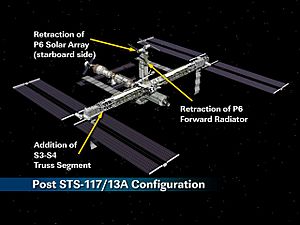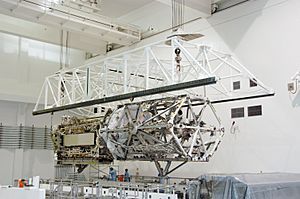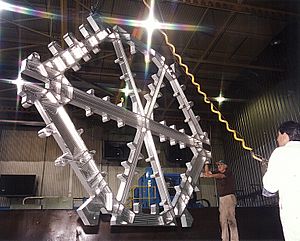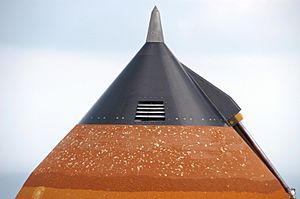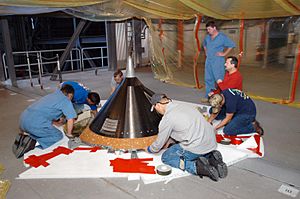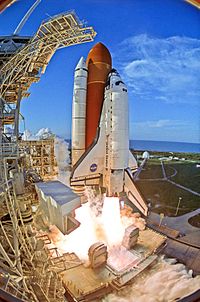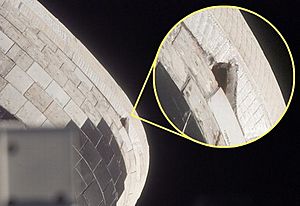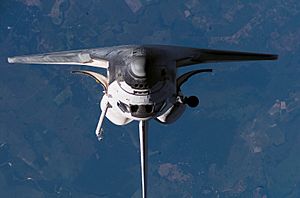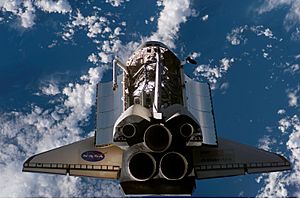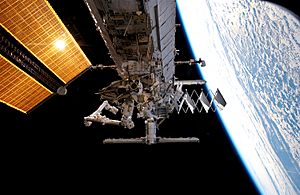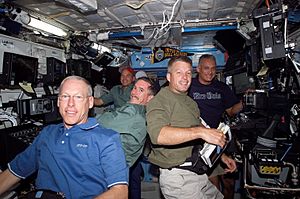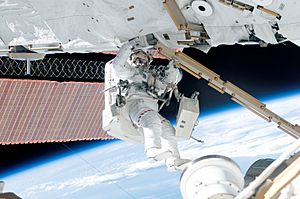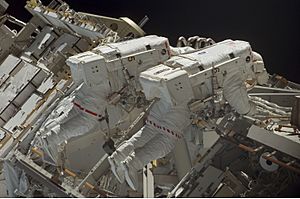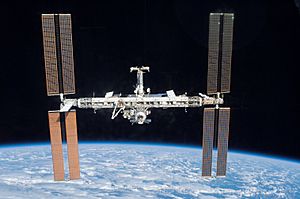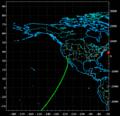STS-117 facts for kids
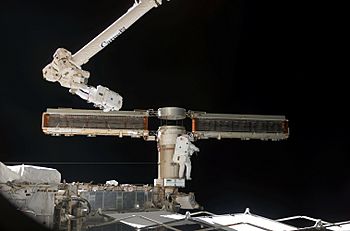
Reilly (left) and Olivas (center) during EVA 3, preparing the folded P6 truss for its relocation
|
|
| Mission type | ISS assembly |
|---|---|
| Operator | NASA |
| Mission duration | 13 days, 20 hours, 12 minutes, 44 seconds |
| Distance travelled | 9,300,000 kilometres (5,800,000 mi) (9,334,000 km) |
| Orbits completed | 219 |
| Spacecraft properties | |
| Spacecraft | Space Shuttle Atlantis |
| Launch mass | 2,052,719 kilograms (4,525,471 lb) (total) 122,683 kilograms (270,469 lb) (orbiter) |
| Landing mass | 90,492 kilograms (199,501 lb) |
| Crew | |
| Crew size | 7 |
| Members |
|
| Launching | |
| Landing | |
| Start of mission | |
| Launch date | 8 June 2007, 23:38:04 UTC |
| Launch site | Kennedy LC-39A |
| End of mission | |
| Landing date | 22 June 2007, 19:49:38 UTC |
| Landing site | Edwards Runway 22 |
| Orbital parameters | |
| Reference system | Geocentric |
| Regime | Low Earth |
| Perigee | 334 kilometres (208 mi) |
| Apogee | 354 kilometres (220 mi) |
| Inclination | 51.6 degrees |
| Period | 91.4 minutes |
| Docking with ISS | |
| Docking port | PMA-2 (Destiny forward) |
| Docking date | 10 June 2007, 19:36 UTC |
| Undocking date | 19 June 2007, 14:42 UTC |
| Time docked | 8 days, 19 hours, 6 minutes |
 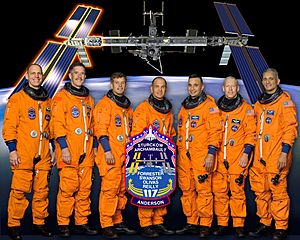 (left to right) Anderson, Reilly, Swanson, Sturckow, Archambault, Forrester and Olivas. |
|
STS-117 was a Space Shuttle mission flown by Space Shuttle Atlantis. It launched from the Kennedy Space Center on June 8, 2007. This mission was important for building the International Space Station (ISS). Atlantis lifted off from the launch pad at 7:38 PM EDT.
The launch was delayed from March 15, 2007, because of damage from a hail storm. The storm hit on February 26, 2007. STS-117 was the 250th time humans had flown into space.
Atlantis carried a large part of the space station called the S3/S4 Truss. This part included new solar panels. These panels help power the station. During the mission, the crew installed the new truss. They also folded up an old set of solar panels and unfolded the new ones. STS-117 also brought a new crew member, Clayton Anderson, to the station. It brought Sunita Williams back to Earth.
On June 11, 2007, NASA decided to make the mission two days longer. This allowed for a fourth spacewalk (EVA). This extra time helped the crew finish all their tasks. During one spacewalk, they even fixed a small tear in the shuttle's heat shield. This mission was the longest for Atlantis. It landed at Edwards Air Force Base on June 22, 2007.
Contents
- Meet the Crew
- What Atlantis Carried
- Getting Ready for Launch
- Mission Diary
- June 8 (Day 1 – Launch!)
- June 9 (Day 2 – Checking the Heat Shield)
- June 10 (Day 3 – Docking with the ISS)
- June 11 (Day 4 – Spacewalk 1)
- June 12 (Day 5 – Solar Panels Unfold)
- June 13 (Day 6 – Spacewalk 2)
- June 14 (Day 7)
- June 15 (Day 8 – Spacewalk 3)
- June 16 (Day 9)
- June 17 (Day 10 – Spacewalk 4)
- June 18 (Day 11 – Relax and Prepare)
- June 19 (Day 12 – Undocking)
- June 20 (Day 13)
- June 21 (Day 14 – Landing Delayed)
- June 22 (Day 15 – Landing!)
- Spacewalks (EVAs)
- Wake-up Songs
- Mission Patch Meaning
- See also
Meet the Crew
| Position | Launching Astronaut | Landing Astronaut |
|---|---|---|
| Commander | Frederick W. Sturckow Third spaceflight |
|
| Pilot | Lee J. Archambault First spaceflight |
|
| Mission Specialist 1 | Patrick G. Forrester Second spaceflight |
|
| Mission Specialist 2 | Steven R. Swanson First spaceflight |
|
| Mission Specialist 3 | John D. Olivas First spaceflight |
|
| Mission Specialist 4 | James F. Reilly Third and last spaceflight |
|
| Mission Specialist 5 | Clayton Anderson Expedition 15 First spaceflight ISS Flight Engineer |
Sunita "Suni" Williams Expedition 15 First spaceflight ISS Flight Engineer |
What Atlantis Carried
The Space Shuttle Atlantis carried several important items to the International Space Station. The biggest piece was a new part of the station's structure.
| What it was | How much it weighed |
|---|---|
| Orbiter Docking System and Spacesuits | About 1,800 kg (3,968 lbs) |
| Power Converter Units | About 90 kg (198 lbs) |
| Truss segment S3/S4 | 16,183 kg (35,678 lbs) |
| Shuttle's Robotic Arm Extension | About 450 kg (992 lbs) |
| Shuttle's Robotic Arm | About 390 kg (860 lbs) |
| Total: | 19,083 kg (42,071 lbs) |
The S3/S4 Truss Segment
The main goal of STS-117 was to deliver the S3/S4 truss segment to the ISS. This truss is a long, strong beam. It helps the station get power and send data. It also helps control the station's temperature. The S3/S4 truss was the heaviest thing the shuttle had ever carried.
The S3/S4 truss is about 13.66 meters (44 feet) long. It is made of stainless steel. It has special parts that let the solar panels turn. This way, the panels can always face the sun. This helps the station make electricity.
On the fourth day of the mission, the crew used the shuttle's robotic arm to take the S3/S4 truss out of the cargo bay. Then, the station's robotic arm took it. The arm then moved it into place on the station.
Starboard 3 (S3) Part
The S3 part of the truss is shaped like a hexagon. It has strong beams that connect its parts. Its main job is to hold the Solar Array Rotary Joint (SARJ). This joint spins the solar panels. It makes sure they always point at the sun. The S3 also lets other parts attach to the station.
Starboard 4 (S4) Part
The S4 part of the truss holds the actual solar panels. It also has a radiator. This radiator helps get rid of heat from the station's electrical parts. The solar panels on S4 are very large. Each one is about 35 meters (115 feet) long. They can also tilt to catch the sun's rays.
Hydrogen Vent Valve
Atlantis also carried a special valve for the station. This valve is part of the system that makes oxygen for the astronauts to breathe. It helps vent extra hydrogen away from the station.
Other Special Items
The shuttle carried a container to transfer water to the ISS. It also had tools to help with repairs. One interesting item was a metal tag from historic Jamestown. This tag was almost 400 years old. It was found in 2006 at the site of the first English settlement in America. It was a way to honor early American explorers.
Getting Ready for Launch
Getting Atlantis ready for STS-117 took a lot of work. The mission was first planned for March 16, 2007. But the date was moved up to give more time for launch.
Atlantis was moved to the Vehicle Assembly Building (VAB) in February 2007. Here, it was attached to its large external fuel tank and solid rocket boosters. These parts together are called the "stack." The S3/S4 truss was also loaded into the shuttle's cargo bay.
The shuttle stack was then moved to Launch Pad 39A. This was the first time a shuttle launched from Pad 39A in four years. Astronauts practiced for the launch. They also checked the shuttle's readiness.
Hailstorm Damage
On February 26, 2007, a big hailstorm hit the Kennedy Space Center. Hailstones as big as golf balls damaged the shuttle and its external tank. The tank's foam insulation got many dents. Some heat shield tiles on Atlantis were also slightly damaged.
Because of this, Atlantis had to be rolled back to the VAB for repairs. Technicians worked hard to fix the damage. After the repairs, Atlantis was rolled back to the launch pad in May 2007. This delay caused other shuttle missions to be pushed back.
Mission Diary
June 8 (Day 1 – Launch!)
Atlantis launched right on time at 7:38 PM UTC from Pad 39A. The launch commentator said, "Liftoff of Space Shuttle Atlantis, to assemble the framework for the science laboratories of tomorrow!" This was the first launch from Pad 39A since the Space Shuttle Columbia disaster in 2003.
The weather was good for launch. The crew boarded Atlantis and the hatch was closed. The ride to orbit was smooth. Only a small piece of debris was seen after the rocket boosters separated. NASA said it likely did not hit the shuttle.
As Atlantis flew into space, the space station was flying over the Indian Ocean. The astronauts on the ISS watched the launch on a video screen. After reaching orbit, the Atlantis crew opened the cargo bay doors. They also checked the shuttle's robotic arm. They saw a small piece of insulation on the shuttle's engine pod had peeled away.
June 9 (Day 2 – Checking the Heat Shield)
On their first full day in space, the crew checked the shuttle's heat shield. This is very important for safe return to Earth. They used the shuttle's robotic arm and a special sensor system. This system scanned the wings and nose cap. They also sent video of the peeled insulation on the engine pod to Mission Control.
Other crew members got the spacesuits ready for spacewalks. They also prepared other tools for docking with the space station.
June 10 (Day 3 – Docking with the ISS)
Atlantis slowly moved closer to the ISS. Before docking, Commander Rick Sturckow performed a special flip. This allowed the station crew to take pictures of the shuttle's underside. They checked for any damage.
Atlantis docked with the ISS at 7:36 PM UTC. This happened while both spacecraft were flying over Australia. After checking for leaks, the hatch opened. The station crew welcomed the shuttle crew. Soon after, astronaut Clayton Anderson officially joined the station crew. Sunita Williams, who was on the station, prepared to return to Earth with Atlantis.
The shuttle's robotic arm then grabbed the S3/S4 truss. It handed it over to the station's robotic arm. The truss stayed attached to the station's arm until it was installed the next day. Two astronauts, James Reilly and John Olivas, spent the night in the airlock. This helped them get ready for the next day's spacewalk.
June 11 (Day 4 – Spacewalk 1)
The station's robotic arm moved the S3/S4 truss into its final position. This prepared for the first spacewalk. Astronauts James Reilly and John Olivas went outside. They released locks on the new solar panels. They also connected cables for the truss.
The spacewalk was delayed for about an hour. This was because the station briefly lost control of its direction. This was due to a problem with its gyroscopes. But the spacewalk started after the gyroscopes were fixed. This was the 84th spacewalk for building and maintaining the ISS.
NASA also decided to add two more days to the mission. This allowed for a fourth spacewalk. The extra time would help finish station tasks. It also gave time to plan how to fix the damaged insulation on Atlantis.
June 12 (Day 5 – Solar Panels Unfold)
The main event of the day was unfolding the new S3/S4 solar panels. These panels greatly increased the station's power. Station controllers started unfolding them. Then, the shuttle crew took over. They unfolded one wing at a time. They paused to let the sun warm the panels. This helped prevent them from sticking together.
There were still some issues with the station's gyroscopes. This was due to a problem with a Russian computer. But by the end of the day, the problems were solved. The station's gyroscopes took over controlling its direction.
June 13 (Day 6 – Spacewalk 2)
Astronauts Patrick Forrester and Steven Swanson performed the second spacewalk. Their main job was to get the Solar Alpha Rotary Joint (SARJ) ready to spin. This joint allows the solar panels to rotate.
They also helped fold up an old solar array on the P6 truss. Flight controllers managed to fold some of it. Then, Forrester and Swanson helped fold more panels by hand. They pushed and prodded them into place.
The spacewalkers removed most of the locks holding the SARJ. But they found a wiring problem. Commands for one part were going to another. So, one lock was left in place to prevent accidental spinning. This spacewalk was the 85th for station assembly.
Mission managers approved a plan to fix the damaged thermal blanket on Atlantis during the next spacewalk.
June 14 (Day 7)
A computer problem on the Russian side of the ISS happened. This left the station without control of its direction. A restart caused a false fire alarm. Engineers thought the new solar array might have caused the electrical issue.
The crew continued to fold the old solar array on the P6 truss. They carefully sent commands to retract it as much as possible. Astronauts James Reilly and John Olivas reviewed plans for the next spacewalk. They also slept in the airlock to prepare for it.
June 15 (Day 8 – Spacewalk 3)
Day 8 was for the third spacewalk. Its goals were to fix Atlantis's thermal blanket and help fold the solar array. Astronauts James Reilly and John Olivas started EVA 3. This was the 86th spacewalk for ISS assembly.
Olivas, holding onto the shuttle's robotic arm, repaired the torn insulation. He used a special stapler and pins. Reilly installed a new hydrogen vent for the oxygen system inside the Destiny lab.
Flight controllers also asked Reilly to disconnect a power connector. They wanted to make sure it wasn't causing problems with the Russian computers. After these tasks, the astronauts, with help from inside, finished folding the old P6 truss solar array. All tasks were completed successfully during the nearly 8-hour spacewalk.
Earlier, engineers tried to fix the Russian computer problem. They disconnected U.S. power from the Russian system. But this didn't solve it. They got the main Russian computers back online by bypassing a circuit.
June 16 (Day 9)
I was just in the right place at the right time. It's an honor to be here.
The Atlantis crew had a lighter day. Astronaut Sunita Williams set a new record for women in space. She had spent 188 days and 4 hours in space. This broke the old record set in 1996. It happened on the 44th anniversary of the first woman in space, Valentina Tereshkova.
Crew members moved supplies between the ISS and Atlantis. They also reviewed plans for the next spacewalk. The astronauts worked on their spacesuits. The shuttle and station crews also talked to reporters.
Earlier, Russian flight controllers restarted more systems. All six Russian computer processors were now working.
June 17 (Day 10 – Spacewalk 4)
Day 10 saw the last spacewalk of the mission. Patrick Forrester and Steven Swanson completed it successfully. The spacewalk began at 4:25 PM UTC.
Swanson and Forrester moved a TV camera to the S3 truss. They also removed the last locks on the SARJ. They cleared the path on the S3 truss for the Mobile Base System. This finished the main tasks for STS-117.
They also did some extra tasks. They installed a computer network cable on the Unity node. This allows U.S. astronauts to control Russian systems. They also opened the hydrogen vent valve. They tried to bolt down two debris shield panels. When they couldn't, they tied them down instead.
Ground controllers planned to test the SARJ overnight. The Russian computers continued to work well.
June 18 (Day 11 – Relax and Prepare)
The STS-117 crew had some time off. They moved the last of the cargo between the shuttle and the station. Flight controllers on Earth tested the station's Russian computers. The shuttle and station moved to dump water and waste. Attitude control was successfully switched to and from Russian control.
Atlantis was cleared to undock on Day 12. The crews said their goodbyes and sealed the hatches between the shuttle and the ISS.
June 19 (Day 12 – Undocking)
The astronauts on Atlantis woke up with the hatch to the space station closed. The crew prepared the shuttle for undocking.
At 9:42 AM, the hooks holding Atlantis and the ISS together were released. The shuttle undocked from the station over New Guinea. Atlantis had been docked for 8 days and 19 hours. Pilot Lee Archambault flew Atlantis away from the station. He then performed a full fly-around. This allowed both crews to take pictures.
During separation, cameras saw small objects floating away. It was not clear if they were from the shuttle or station. Later, Commander Sturckow saw more debris. He said they looked like small washers.
The crew then used the shuttle's robot arm to inspect the heat shield again. Astronaut Sunita Williams continued her exercises. These helped her prepare for returning to Earth's gravity.
June 20 (Day 13)
Atlantis performed various hardware tests. These were to get ready for landing. The crew also had interviews with TV networks.
June 21 (Day 14 – Landing Delayed)
Atlantis closed its cargo bay doors. It made preparations for landing. But both landing chances at Kennedy Space Center were canceled. This was due to bad weather. So, Atlantis had to stay in orbit.
June 22 (Day 15 – Landing!)
On Day 15, Space Shuttle Atlantis returned to Earth. It completed its successful mission.
Flight controllers watched the weather closely. Atlantis again prepared for landing. The first two landing attempts in Florida were canceled due to storms. So, controllers chose Edwards Air Force Base in California. The weather there was perfect.
Commander Rick Sturckow and Pilot Lee Archambault fired Atlantis's engines. This slowed the shuttle down by about 320 km/h (200 mph). This was enough to start its glide back to Earth.
As the shuttle came down, Commander Sturckow took manual control. He guided Atlantis to a smooth landing on Runway 22 at Edwards Air Force Base. The landing happened at 7:49 PM UTC. Astronaut Sunita Williams, who had spent 194 days in space, rested in a special seat.
Atlantis completed 219 orbits. It traveled 9.3 million kilometers (5.8 million miles). A welcome ceremony for the crew was held in Houston the next day.
-
Atlantis at a refuel stop at Offutt Air Force Base, Omaha, Nebraska
-
Atlantis is towed back to the Orbiter Processing Facility to be prepared for STS-122
Spacewalks (EVAs)
Astronauts on STS-117 performed four spacewalks. These were crucial for building and maintaining the International Space Station.
| EVA Number | Spacewalkers | Start Time (UTC) | End Time (UTC) | How Long |
|---|---|---|---|---|
| EVA 1 | James F. Reilly John D. Olivas |
June 11, 2007 8:02 PM |
June 12, 2007 2:17 AM |
6 hours 15 minutes |
| Reilly and Olivas released locks on the new S4 solar panels. They installed a rotary joint part and released latches for a radiator panel. | ||||
| EVA 2 | Patrick G. Forrester Steven Swanson |
June 13, 2007 6:28 PM |
June 14, 2007 1:44 AM |
7 hours 16 minutes |
| Forrester and Swanson removed locks from the solar alpha rotary joint. They tried to install a drive-lock part but found a wiring issue. They also helped fold the P6 solar array. | ||||
| EVA 3 | James F. Reilly John D. Olivas |
June 15, 2007 5:24 PM |
June 16, 2007 1:22 AM |
7 hours 58 minutes |
| Olivas repaired a thermal blanket on Atlantis using a stapler. Reilly installed a hydrogen vent valve for the oxygen system. They both helped finish folding the P6 solar array. | ||||
| EVA 4 | Patrick G. Forrester Steven Swanson |
June 16, 2007 4:25 PM |
June 16, 2007 10:54 PM |
6 hours 29 minutes |
| Swanson and Forrester moved a TV camera to the S3 truss. They removed the last SARJ locks. They also installed a computer cable and opened the hydrogen vent valve. They tied down some loose debris shield panels. | ||||
Wake-up Songs
It's a tradition for NASA missions to play a special song for the crew each morning. These songs are often chosen for a specific astronaut or relate to the mission.
| Flight Day | Song | Artist | Played for | Links |
|---|---|---|---|---|
| Day 2 | "Big Boy Toys" | Aaron Tippin | Rick Sturckow | wav mp3 transcript |
| Day 3 | "Riding the Sky" | David Kelldorf and Brad Loveall | Clayton Anderson | wav mp3 transcript |
| Day 4 | "It Probably Always Will" | Ozark Mountain Daredevils | Steven Swanson | wav mp3 transcript |
| Day 5 | "What a Wonderful World" | Louis Armstrong | John "Danny" Olivas | wav mp3 transcript |
| Day 6 | "Questions 67 and 68" | Chicago | Lee Archambault | wav mp3 transcript |
| Day 7 | "Indescribable" | Chris Tomlin | Patrick Forrester | wav mp3 transcript |
| Day 8 | "Radar Love" | Golden Earring | Steven Swanson | wav mp3 transcript |
| Day 9 | "University of Texas El Paso Fight Song" | UTEP | John "Danny" Olivas | wav mp3 transcript |
| Day 10 | Theme song from "Band of Brothers" | James Reilly | wav mp3 transcript |
|
| Day 11 | "Redeemer" | Nicole C. Mullen | Patrick Forrester | wav mp3 transcript |
| Day 12 | "Feelin' Stronger Every Day" | Chicago | Lee Archambault | wav mp3 transcript |
| Day 13 | "If I Had a Million Dollars" | Barenaked Ladies | Sunita Williams | wav mp3 transcript |
| Day 14 | "Makin' Good Time Coming Home" | John Arthur Martinez | Rick Sturckow and Jim Reilly | wav mp3 transcript |
| Day 15 | "The Marines' Hymn" | The Marine Corps Band | Rick Sturckow | wav mp3 transcript |
Mission Patch Meaning
The STS-117 crew patch shows the ongoing building of the space station. It also shows humans living in space. The ISS is seen orbiting Earth. The gold color highlights the part of the ISS that the STS-117 crew installed. The astronauts' names are around the station. The two gold astronaut symbols show the teamwork between the Space Shuttle and space station programs. They work together to finish the station. The shuttle and the red, white, and blue banner show American pride. They represent the continued exploration of space.
See also
 In Spanish: STS-117 para niños
In Spanish: STS-117 para niños


